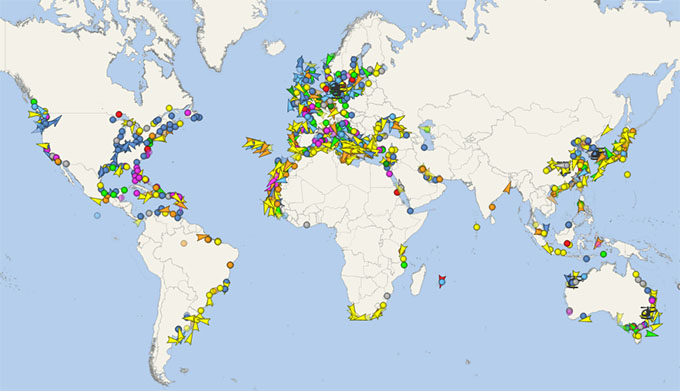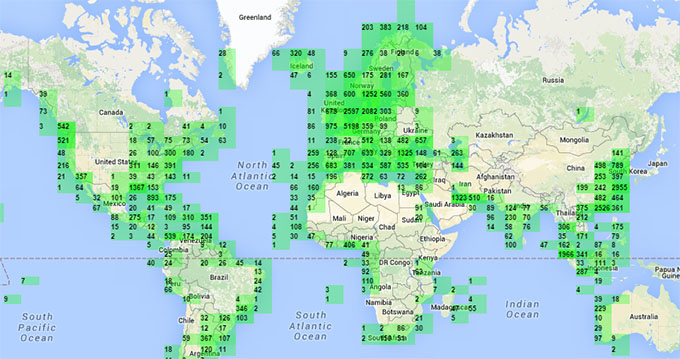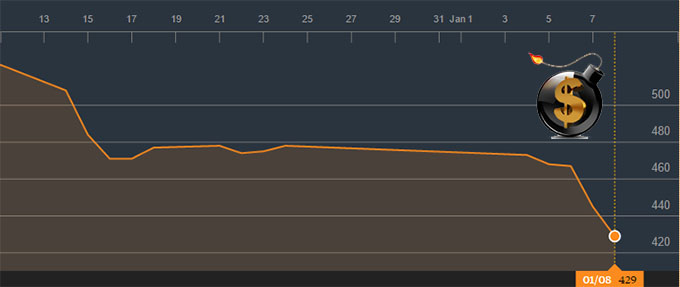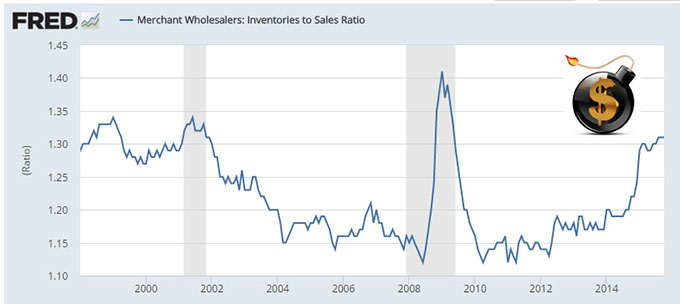Retail Apocalypse
Barack Obama recently stated that anyone that is claiming that America’s economy is in decline is “peddling fiction“. Well, if the economy is in such great shape, why are major retailers shutting down hundreds of stores all over the country?
Last month, I wrote about the “retail apocalypse” that is sweeping the nation, but since then it has gotten even worse. Closing stores has become the “hot new trend” in the retail world, and “space available” signs are going up in mall windows all over the United States. Barack Obama can continue huffing and puffing about how well the middle class is doing all he wants, but the truth is that the cold, hard numbers that retailers are reporting tell an entirely different story.
Earlier today, Sears Chairman Eddie Lampert released a letter to shareholders that was filled with all kinds of bad news. In this letter, he blamed the horrible results that Sears has been experiencing lately on “tectonic shifts” in consumer spending…
In a letter to shareholders on Thursday, Lampert said the impact of “tectonic shifts” in consumer spending has spread more broadly in the last year to retailers “that had previously proven to be relatively immune to such shifts.”“Walmart, Nordstrom, Macy’s, Staples, Whole Foods and many others have felt the impact of disruptive changes from online competition and new business models,” Lampert wrote.
And it is very true – Sears is doing horribly, but they are far from alone. The following are 13 major retailers that are closing down stores…
#1 Sears lost 580 million dollars in the fourth quarter of 2015 alone, and they are scheduled to close at least 50 more “unprofitable stores” by the end of this year.
#2 It is being reported that Sports Authority will file for bankruptcy in March. Some news reports have indicated that around 200 stores may close, but at this point it is not known how many of their 450 stores will be able to stay open.
#3 For decades, Kohl’s has been growing aggressively, but now it plans to shutter 18 stores in 2016.
#4 Target has just finished closing 13 stores in the United States.
#5 Best Buy closed 30 stores last year, and it says that more store closings are likely in the months to come.
#6 Office Depot plans to close a total of 400 stores by the end of 2016.
The next seven examples come from one of my previous articles…
#7 Wal-Mart is closing 269 stores, including 154 inside the United States.
#8 K-Mart is closing down more than two dozen stores over the next several months.
#9 J.C. Penney will be permanently shutting down 47 more stores after closing a total of 40 stores in 2015.
#10 Macy’s has decided that it needs to shutter 36 stores and lay off approximately 2,500 employees.
#11 The Gap is in the process of closing 175 stores in North America.
#12 Aeropostale is in the process of closing 84 stores all across America.
#13 Finish Line has announced that 150 stores will be shutting down over the next few years.
These store closings can be particularly cruel for small towns. Just consider the impact that Wal-Mart has had on the little town of Oriental, North Carolina…
The Town’n Country grocery in Oriental, North Carolina, a local fixture for 44 years, closed its doors in October after a Wal-Mart store opened for business. Now, three months later — and less than two years after Wal-Mart arrived — the retail giant is pulling up stakes, leaving the community with no grocery store and no pharmacy.
Though mom-and-pop stores have steadily disappeared across the American landscape over the past three decades as the mega chain methodically expanded, there was at least always a Wal-Mart left behind to replace them. Now the Wal-Marts are disappearing, too.
Of course there are many factors involved in this ongoing retail apocalypse. Competition from online retailers is becoming more intense, and consumer spending patterns are rapidly changing.
But in the end, the truth is that you can’t get blood out of a rock. The middle class in America is shrinking, and there just isn’t as much discretionary spending going on as there used to be.
And now that we have entered a new economic downturn, many retailers are finding that there are some local communities that can no longer support their stores. The following comes from CNBC…
Though the shift to online shopping is no doubt playing a role in lighter foot traffic at malls, there’s more to their changing economics than the rise of Amazon. Changing demographics in a town are another reason a shopping center could struggle or fail — for example, if massive layoffs in a particular industry cause people to move away to find employment.“A lot of people want to try and tie it to the Internet or ‘that’s not cool,’ or teens don’t like it,” Jesse Tron, a spokesman for industry trade group International Council of Shopping Centers, told CNBC last year. “It’s hard to support large-format retail in those suburban areas when people are trying to just pay their mortgage.”
In order to have a thriving middle class, we need good paying middle class jobs. Unfortunately, our economy has been bleeding those kinds of jobs quite rapidly. For example, Halliburton just announced that it is eliminating 5,000 more jobs after getting rid of 4,000 workers at the end of last year.
During the Obama years, good paying middle class jobs have been getting replaced by low paying service jobs. At this point, 51 percent of all American workers make less than $30,000 a year.
And there is no way that you can support a middle class family with children on $30,000 a year.
We have an economy that is in the process of failing. We can see it in the explosion of subprime auto loans that are going bad, we can see it in the hundreds of retail stores that are shutting down, and we can see it in the tens of thousands of good paying energy jobs that are being lost.
During the Obama years, interest rates have been pushed to the floor, the Federal Reserve has created trillions of dollars out of thin air, and the size of our national debt is getting close to doubling. Despite all of those desperate measures, our economy continues to crumble.
We stole from the future to try to paper over our failures and it didn’t work. Now an economic downturn that will ultimately turn out to be even worse than the “Great Recession” of 2008 and 2009 has begun, and our leaders have absolutely no idea how to fix things.
I wish I had better news to report, but I don’t. Get prepared now, because very rough times are ahead.
Source: http://www.zerohedge.com
Shipping Said to Have Ceased… Is the Worldwide Economy Grinding to a Halt?
Last week, I received news from a contact who is friends with one of the biggest billionaire shipping families in the world. He told me they had no ships at sea right now, because operating them meant running at a loss.
This weekend, reports are circulating saying much the same thing: The North Atlantic has little or no cargo ships traveling in its waters. Instead, they are anchored. Unmoving. Empty.
We checked VesselFinder.com and it appears to show no ships in transit anywhere in the world. We aren’t experts on shipping, however, so if you have a better site or source to track this apparent phenomenon, please let us know.
We also checked MarineTraffic.com, and it seemed to show the same thing. Not a ship in transit…
If true, this would be catastrophic for world trade. Even if it’s not true, shipping is still nearly dead in the water according to other indices. The Baltic Dry Index, an assessment of the price of moving major raw materials by sea, was already at record all-time lows a month ago.
In the last month it has dropped even more, especially in the last week.
Factories aren’t buying and retailers aren’t stocking. The ratio of inventory to sales in the US is an indicator of this. The last time that ratio was this high was during the “great recession” in 2008.
Hey, Ms. Yellen, what recovery? The economy is taking on water at a rapid rate.
The storm has been building for some time, actually. Not so long ago, there was a spate of reports that the world’s automobile manufacturers were in trouble because cars were not selling and shipments were backing up around the world.
ZeroHedge reported on it this way:
In the past several years, one of the topics covered in detail on these pages has been the surge in such gimmicks designed to disguise lack of demand and end customer sales, used extensively by US automotive manufacturers, better known as “channel stuffing”, of which General Motors is particularly guilty and whose inventory at dealer lots just hit a new record high.
Here is a photo of unsold cars in the United Kingdom from that article.
The world’s economy seems in serious trouble. You can’t print your way to prosperity. All you are doing is hollowing out your economy. Draining it. And sooner or later it’s empty and you have to start over after a good deal of crisis and chaos.
It’s no coincidence that China is struggling desperately to contain a stock implosion. Reportedly, banks have been told they are forbidden to buy US dollars and numerous Chinese billionaires have gone missing. And the markets have just opened on Monday and are again deeply in the red.
Here at The Dollar Vigilante we’ve specialized in explaining the reality of the global faux-economy and why it’s important that you not believe mainstream media lies.
Every month we publish at least two editions of our TDV newsletter that, as our subscribers are aware, has predicted much of what is going on today. If you’re not a subscriber, you ought to take advantage of our current low rates before they go up on February 1. You can subscribe here.
And set aside time for our one-day TDV Internationalization & Investment Summit that features some of the most insightful financial minds on the planet including Ed Bugos our extraordinary, in-house gold analyst and Austrian economist. I’ll be there as well as a presenter and also to answer your questions about our upcoming Super Shemitah Trends and Jubilee Year analysis.
We’ve gained literally thousands of subscribers because of the accuracy of our forecasting and investment recommendations over the past year. Now is your chance – perhaps a final one – to get out in front of the chaos racing toward us by attending our one-day Investment Summit, followed by the three-day Anarchapulco Conference.
I guarantee you’ll come away refreshed, invigorated and armed with insights to help you cope with what’s going to be a very volatile and challenging 2016.
In the meantime, keep your eye on this shipping story! If it is true and worldwide shipping is disastrously foundering, it’ll only be a matter of days before grocery store shelves will reflect that with increasingly bare shelves.
Are people upset now? Just wait. Interruptions in goods and services, most critically food, almost happened in 2008 during the Great Financial Crisis. For three days worldwide shipping was stranded due to shipping companies not knowing whether or not the receiver’s bank credit was good.
That crisis was staved off due to a massive amount of money printing. It was a temporary stay of execution, like bailing out the Titanic with coffee cups, however, and one that may reach much larger proportions in 2016.
Sailors watch the weather to see if it is safe to set sail. Investors should be watching the economic climate with the same intensity.
We are already sailing through very stormy waters.
Source: http://www.marketoracle.co.uk






 Enhancement for Bodies and Minds
Enhancement for Bodies and Minds LifeLink
LifeLink Reinventing the Fountain of Youth
Reinventing the Fountain of Youth When You're Not Looking For The Exit
When You're Not Looking For The Exit